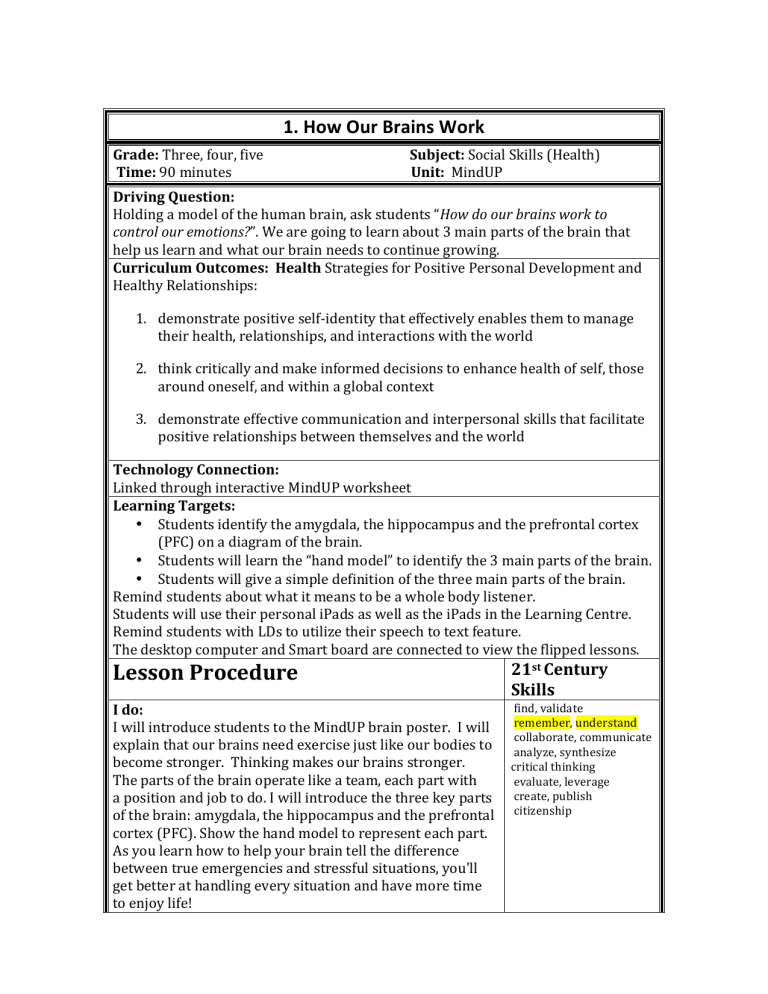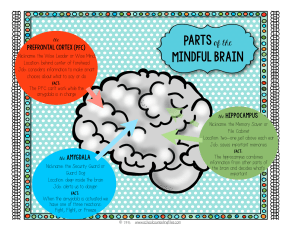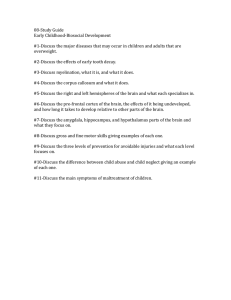
1. How Our Brains Work Grade: Three, four, five Subject: Social Skills (Health) Time: 90 minutes Unit: MindUP Driving Question: Holding a model of the human brain, ask students “How do our brains work to control our emotions?”. We are going to learn about 3 main parts of the brain that help us learn and what our brain needs to continue growing. Curriculum Outcomes: Health Strategies for Positive Personal Development and Healthy Relationships: 1. demonstrate positive self-­‐identity that effectively enables them to manage their health, relationships, and interactions with the world 2. think critically and make informed decisions to enhance health of self, those around oneself, and within a global context 3. demonstrate effective communication and interpersonal skills that facilitate positive relationships between themselves and the world Technology Connection: Linked through interactive MindUP worksheet Learning Targets: • Students identify the amygdala, the hippocampus and the prefrontal cortex (PFC) on a diagram of the brain. • Students will learn the “hand model” to identify the 3 main parts of the brain. • Students will give a simple definition of the three main parts of the brain. Remind students about what it means to be a whole body listener. Students will use their personal iPads as well as the iPads in the Learning Centre. Remind students with LDs to utilize their speech to text feature. The desktop computer and Smart board are connected to view the flipped lessons. Lesson Procedure 21st Century Skills I do: I will introduce students to the MindUP brain poster. I will explain that our brains need exercise just like our bodies to become stronger. Thinking makes our brains stronger. The parts of the brain operate like a team, each part with a position and job to do. I will introduce the three key parts of the brain: amygdala, the hippocampus and the prefrontal cortex (PFC). Show the hand model to represent each part. As you learn how to help your brain tell the difference between true emergencies and stressful situations, you'll get better at handling every situation and have more time to enjoy life! find, validate remember, understand collaborate, communicate analyze, synthesize critical thinking evaluate, leverage create, publish citizenship What are your favourite memories? The most useful facts you know? The hippocampus creates, stores, and processes all important facts and memories the PFC passes on to it -­‐ such as texting shortcuts, your class schedule, and the deep, warm smell of freshly baked buns or bread. The amygdala is programed to keep you safe at all costs (FFF – Fight, Freeze, Flee). It regulates and blocks information from going to your PFC, so when you need to, you can react in a flash. The problem is, it cannot tell a stressful situation from a true emergency and it can cause you to react without thinking. Mindful practice can help keep the amygdala in check so that you can think clearly. Breathing Want to keep your amygdala in check when you get stressed out? Breath DEEPLY! Deep, full breathing calms your amygdala and helps you think and remember clearly. The prefrontal cortex, or PFC, is your key for making thoughtful decisions, doing careful calculations, talking through a problem, and staying focused on what you are doing. Here is the catch…the PFC gets information only when the amygdala is CALM. The PFC passes on to the hippocampus anything that is worth remembering. You do: Students will complete an activity sheet. “Getting to Know and Love Your Brain”. Practice saying the names of each part and become familiar with the model as it is passed around. Knowing the job or function is important so that you start to think about thinking – how you learn, remember, solve problems, understand yourselves and other people. Add colour if time allows. We do: Interactive Activity page with a group. Using the MindUP interactive worksheet, students will work with a partner to learn more about the brain’s capacity to learn and how important breathing is to our brain’s health. Support students by ensuring that all students are involved in the worksheet’s hyperlinks. Students will receive immediate feedback on their understanding of the brain with a quick “quiz” of what each hand symbol means. We share: With the whole group, ask students to demonstrate their find, validate remember, understand collaborate, communicate analyze, synthesize critical thinking evaluate, leverage create, publish citizenship find, validate remember, understand collaborate, communicate analyze, synthesize critical thinking evaluate, leverage create, publish citizenship find, validate remember, understand understanding of the parts by sharing a few scenarios: • Imagine this: you are asleep and a loud crash wakes you up. How does your body immediately react? What are you thinking? How does your body feel? • Which part of your brain will keep you safe – your brain’s wise leader (PFC), your brain’s security guard (the amygdala) or your brain’s memory saver (the hippocampus)? Encourage students to share stories of when they were startled or scared (be sensitive that some students may not want to share). Talk about how the body reacts. Conclude the lesson by sharing that future lessons will • Help them to calm their amygdalas when there’s no immediate threat • Strengthen their ability to focus by getting information to the PFC efficiently • Help them to store important ideas in their hippocampus collaborate, communicate analyze, synthesize critical thinking evaluate, leverage create, publish citizenship Differentiation Students can use iPads to take photos and complete the work digitally rather than paper and pencil. Use the apps Readiris and Claro. Adaptations: Enrichment: Non readers will be paired with a higher Provide the link to Prezi Lesson 1: academic, supportive student MindUp Parts of the Brain. Using Apple iPad accessibility features to read text Students with LDs can use text to speech Evaluation: Students will be evaluated using a checklist and anecdotal notes to determine their understanding of self-­‐regulation. Teacher Reflection: Be mindful of students who may be uncomfortable sharing what frightens them.

